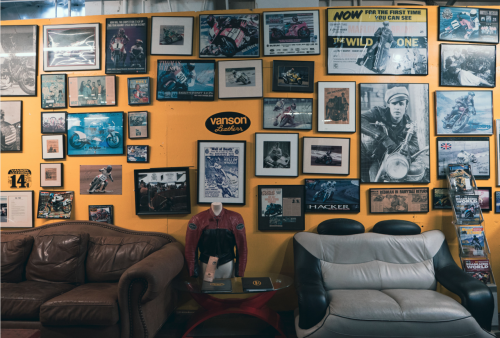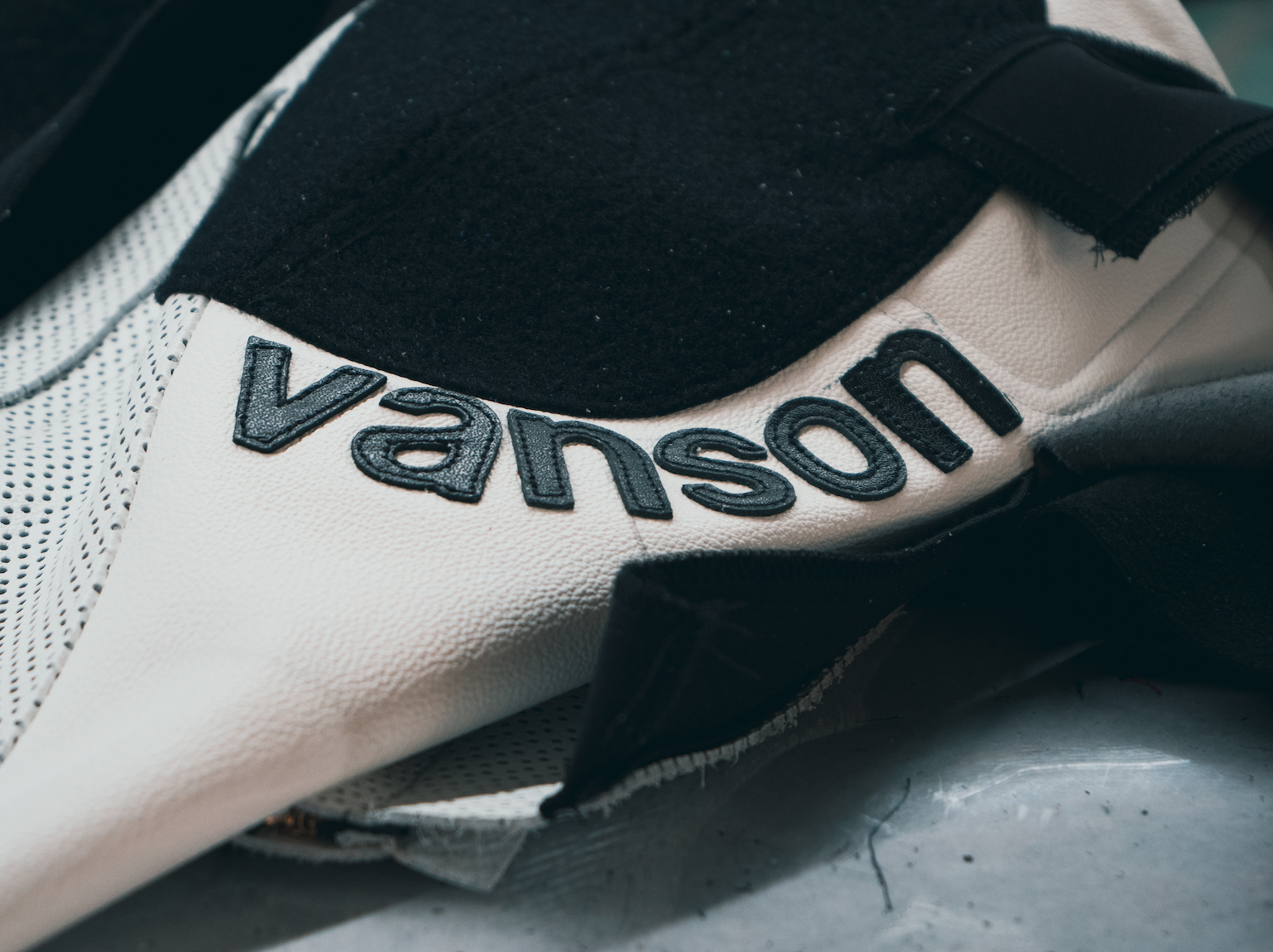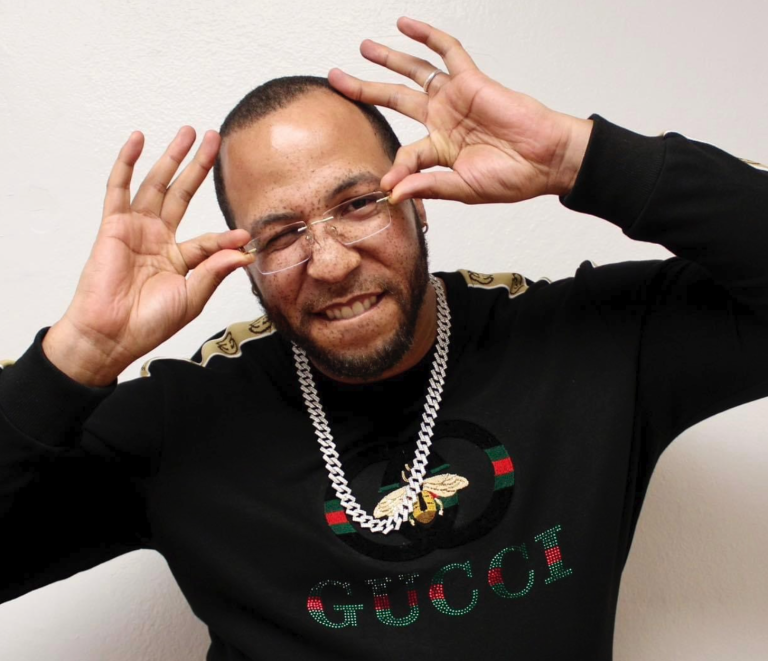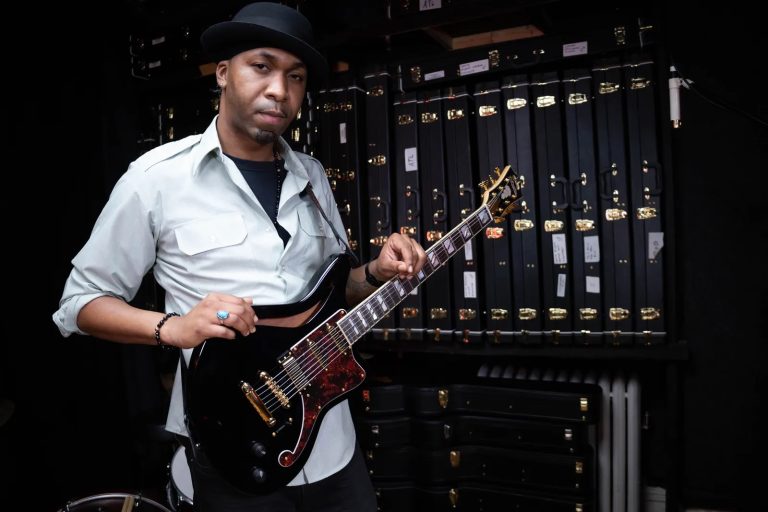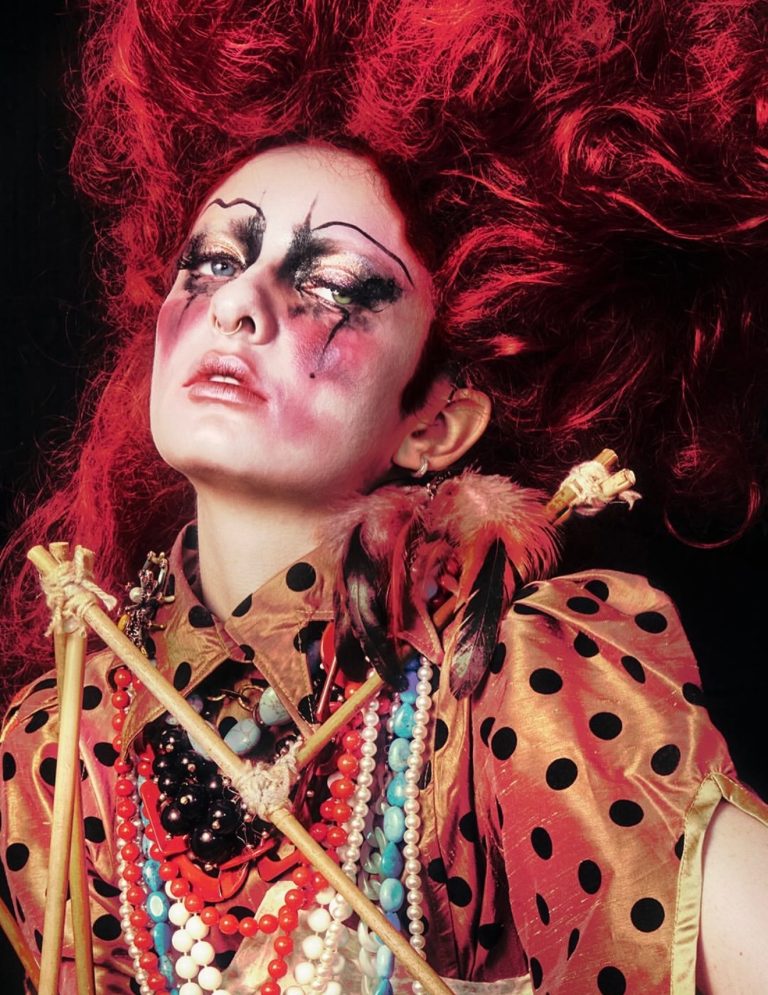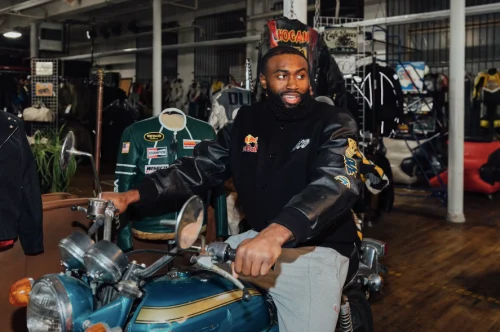
JAYLEN BROWN is known for hitting big shots on the court and taking big swings in the fashion world. When the Celtics star wanted to disrupt the game with a new line of leather jackets, he called Vanson Leathers.
When LeBron James rolled into Crypto.com Arena wearing a custom leather jacket on his way to making NBA history with his 40,000th point, he carried a piece of Fall River with him. His jacket—a collaboration between luxury brand Aimé Leon Dore and Vanson Leathers.
In Los Angeles, Kim Kardashian was spotted at her kids’ basketball game, wearing Vanson Leathers Split Pants from Supreme x Yohji Yamamoto. The A-list celebrity bringing high fashion to being a soccer mom, or in this case, a basketball mom. It’s safe to say that Vanson’s products are known across the world.
Those pieces are more than just fashion statements. They embody a half-century legacy of American craftsmanship. As Vanson Leathers celebrates its 50th anniversary this year, it’s a moment that perfectly encapsulates how far the company has come from its humble beginnings.
“The main thing is that you have to establish a brand, and then you have to establish the brand with consistent DNA,” explains Mike van der Sleesen, founder of Vanson Leathers. “We will always manufacture for racing things, drag racing, road racing… that has always been a big part of the DNA.”
By his side through all of this, is his wife Kim van der Sleesen. Kim beams with pride as she describes their journey: “One of the things I appreciate is being able to say, yes… Maybe they want something in purple, and maybe they want their name all over it… You can make their dreams come true.”
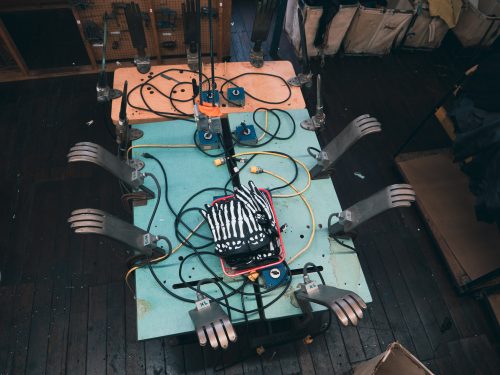
The Birth of an American Icon
The early days in Boston’s South End were marked by a steep learning curve. “We really didn’t know anything, and we knew so little, we thought it was easy,” Mike admits. “We ended up renting a loft on Thayer Street… it had just been converted from a central steam engine running leather belts and elevator shafts and power shafts to electric motors.”
The business environment then was radically different from today. “In the South End, all of the New England Street area, the whole Chinatown area, the leather district… those were districts where businesses congregated,” he explains. “They made shoes, handbags, gloves… everything they possibly wanted.”
The move to Fall River in 1987 came during what Mike calls “the Massachusetts miracle”—when Boston’s economy was overheating. “The idea was you can go to New Hampshire and pay no taxes but maybe you don’t find any help, or you go to Fall River where if you don’t make any money, you don’t pay any taxes anyway, but at least you’ll find help.”
Today, the van der Sleesens speak of their adopted city with obvious affection: “Fall River is definitely on the march, on the move. It’s what I would call a very cosmopolitan city.” Mike enthusiastically describes the city’s rich cultural tapestry: “We’ve got Amaral’s Central Market, which sells incredibly fresh, hand-cut meats… Sagres restaurant, which is really world class… the Narrows, which has the music and the festivals.”
The diversity of Fall River particularly stands out: “We’ve got Lebanese and Cape Verdeans and Brazilians… Muslims, Catholics, Protestants, Jews. Everybody coexists here… It’s becoming more prosperous and more comfortable in itself.”
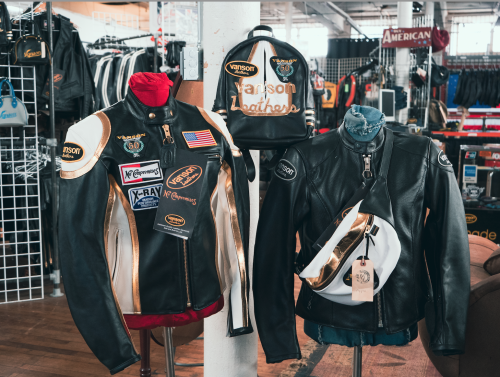
A Family Legacy
The story of Vanson is also a love story. Kim joined the company after answering a help wanted ad in The Boston Globe in 1992. “That’s how you meet people,” she reflects. “You spend more time with them, right? And I spent a lot of time at work.”
Now married for 22 years, they run the business together with a shared dedication that never wavers.
“You own your own company, you don’t ever turn it off,” Kim explains. “It wakes you up at night, or you’re thinking about it while you’re stirring soup on the stove, or that’s when your inspiration sometimes comes standing under the shower in the morning. It’s rare that it’s not front and center in your consciousness.”
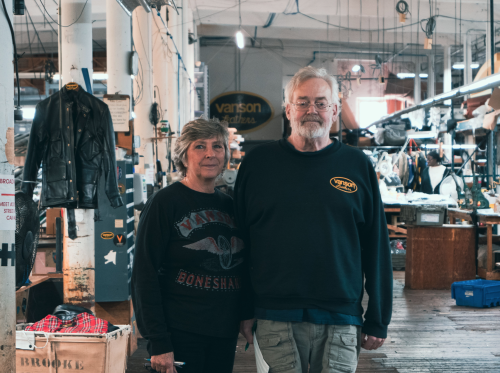
The Jaylen Brown Collaboration: A New Chapter
The legacy of Vanson continues to evolve through meaningful collaborations, most recently with NBA star Jaylen Brown and his apparel brand 7uice. Brown, known for challenging conventional expectations of athlete entrepreneurs, was drawn to Vanson’s commitment to craftsmanship and community values.
“When I created 7uice, the core identities of the brand centered on three pillars,” Brown told USA Today earlier this year. “Community, energy, and style.” He found these same attributes reflected in Vanson’s history and approach to manufacturing.
The collaboration draws inspiration from one of Vanson’s most iconic designs – the skeleton motif racing suit originally worn by motorcycle racing legend David Aldana in 1975. This design choice reflects both brands’ commitment to disrupting industry norms while honoring heritage.
Mike particularly appreciates Brown’s community involvement: “He’s a great giver, backer to the community. It’s very noteworthy that he says what he means, and then means what he says, and follows through.” This alignment of values has made the partnership especially meaningful for both parties.
The collaboration has gone beyond mere product design. Brown has taken a personal interest in Vanson’s manufacturing process, visiting the Fall River factory to meet the craftspeople who hand-make each jacket. This attention to the human element of manufacturing reflects both Brown’s community-focused approach and Vanson’s longstanding commitment to preserving American craftsmanship.
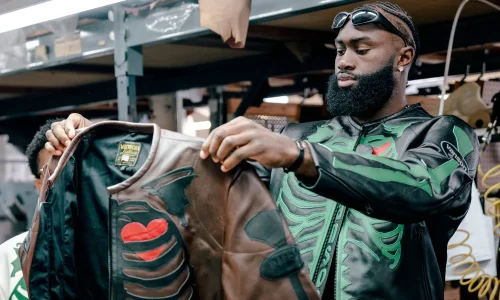
The Art of Collaboration
Vanson’s approach to collaborations reflects their commitment to authenticity and craftsmanship. “We’ve never allowed Vanson to be just a cut, make and sew operation,” Mike emphasizes. “Everything we do has always been a Vanson co-brand. You can have it, but we’re buying this and not something else.”
Kim elaborates on their selective approach: “Being a small organization, we can’t say yes to everyone, and we wouldn’t even if we could, because then, of course, it becomes more ordinary. We keep it special.”
Over the years, Vanson has attracted an impressive roster of celebrity clients, often in surprisingly casual ways. Van der Sleesen recalls with amusement the day Larry Bird walked into their shop: “He’s like, 6’9”. He needs a jacket. And I said, ‘Oh, I think we need to make a longer one, right?’ He’s like, ‘Okay, what’s your name?’ ‘This is Larry.’ And I write it down. I said, ‘Last Name?’ ‘Bird.’ Name sounds familiar… I never knew!”
From rebellious rock stars to modern entertainment icons, Vanson leather jackets have been a symbol of timeless cool across generations of celebrities. Steve McQueen set the standard by sporting Vanson’s motorcycle racing gear, while punk pioneer Joey Ramone made the Rock and Roll jacket a staple of the CBGB scene. In more recent years, the brand’s appeal has transcended genres and cultures, with Alicia Keys bringing elegance to the Star jacket in her music videos, Axl Rose commanding stages in the iconic Bones design, and Usher adding his R&B flair to the flat-track motorcycle jacket. Jason Momoa took his passion for motorcycles and leather to the next level by collaborating with Harley-Davidson on a Vanson-crafted design, while Pharrell Williams put his own spin on the classic by wearing a Bones jacket in reverse colors, demonstrating how the brand continues to evolve while maintaining its authentic edge.
“More often than not, they purchase that themselves and we don’t even know about it,” Kim notes.
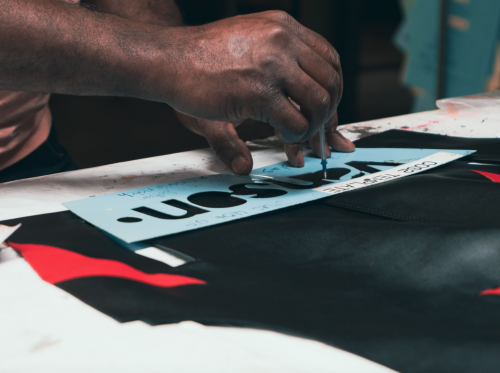
A Rising Sun in the World of Handcrafted Fashion: Vanson and Madrugada
And those collaborations also happen across New England. When Nan James began making hats on her Boston porch in 2016, she likely never envisioned her brand, Madrugada, evolving into a partnership with a legendary American leather company like Vanson. But as her designs gained popularity, she built a backyard store that became a unique hub for customers eager to find her distinct clothing and accessories. Today, Madrugada—which means “the moment before the sun rises”—reflects her philosophy: out of darkness, a new light emerges, much like her brand’s own journey.
Her collaboration with Vanson began serendipitously when a mutual friend, a then-Vanson representative, encouraged her to visit their Fall River factory. Initially unsure of how her style would meld with a motorcycle brand, James quickly changed her mind. “When I went to Vanson and saw everybody literally doing everything by hand, my mind automatically went into producer mode,” she recalls, marveling at the factory’s setup. “Their computers still have buttons on them from, like, elementary school, but each jacket goes through someone’s hands.” The experience inspired James, who is also a seasoned TV producer with Peabody and Emmy accolades, to envision both a story and a product.
Together with Vanson’s team, James designed a collection that included a star jacket customized with her childhood home logo—a personal touch that brought her childhood memories of Roxbury into a piece of wearable art. This jacket, worn by fans across New York, LA, and even internationally, carries James’ roots on its sleeves. “You’ve got people from New York, people from Los Angeles, people overseas wearing it, and you’ve got this little house from Roxbury going around the world.”
James embraces the handcrafted ethos of Vanson in her own work, a rare approach that has built Madrugada’s reputation for high quality and exclusivity. “When you’re doing something by hand, it’s gonna take a while,” she says. “But every time anybody gets it, they’re like, ‘Oh my God, it’s worth the wait.’” It’s a sentiment that reflects Vanson’s commitment to quality and longevity, and it’s exactly what makes their partnership so fitting.
James is part of a quiet but rising generation redefining the standard for American craftsmanship. “Everybody thinks there’s a man behind the brand,” she laughs, sharing how her dedication to fashion often surprises customers. “It’s a woman who likes to dress men!” With her passion, precision, and commitment to heritage craftsmanship, Nan James is bringing a new generation into the world of Vanson, ensuring that her designs—and Vanson’s legacy—shine as brightly as the morning sun.
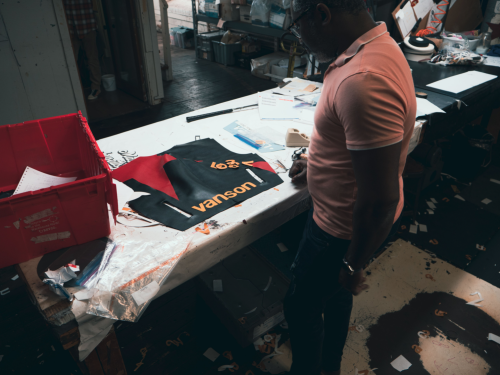
Innovation in Tradition
While Vanson is known for preserving traditional craftsmanship, they’re equally committed to innovation. The company holds multiple patents for features such as ventilation and protection in racing suits. “We’ve really staked out a mixture of innovation and the craft of making beautiful things,” Mike explains.
Their reconditioning service exemplifies this blend of tradition and innovation. “We do a lot of reconditioning,” Mike adds. “We have suits that are 30-40 years old, which is very unusual and part of our DNA. When we do the reconditioning, we actually put the leather in a washing machine with the same solvents and oils that are used in the tanning of the leather, so the fibers are really free, renourished.”
Every garment carries a serial number, embossed both in the inside pocket and on the key fob – a practice that began after a memorable court case involving stolen merchandise. “If you look on eBay,” Mike notes, “quite a few are selling for a hell of a lot more than anyone else’s new ones. That’s supported by the full philosophy Vanson has – you’re not acquiring a leather jacket, you’re acquiring an heirloom and a handmade one.”
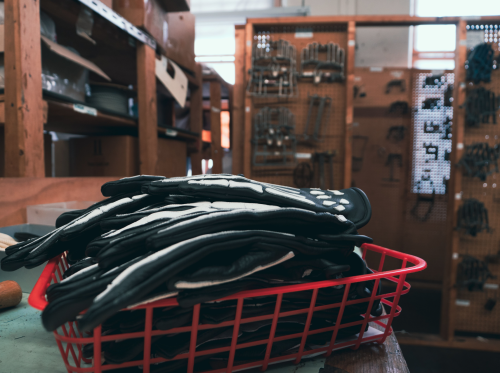
Looking to the Future
As Vanson celebrates its 50th anniversary, the van der Sleesens sees unlimited potential ahead. “I don’t think that there’s a limit to what can be done,” Mike says. “The challenge ahead of us is to become better at what we do than ever. I think there’s a latent demand for special, beautiful things that are produced in a timely manner.”
This optimism is tempered with the realism of someone who’s weathered five decades of industry changes. “Out of all the thousands of businesses that were like this, we’re still here and they’re not,” Kim reflects. “If that carries forward, if we are able to define our niche and become better and better at it and creative, that would be a great legacy, because that is almost in the face of what you see all around you.”
For the van der Sleesens, success isn’t just about survival—it’s about maintaining their standards while evolving with the times. In an age of disposable fashion and offshore manufacturing, Vanson remains steadfast in its commitment to quality American craftsmanship. As Mike puts it, “At one point in America, what we do here was common and was not considered particularly valuable. Now we are considered at least interesting, and maybe even valuable. The fact that we can actually take a raw material and end up with a finished product—and a desirable product—is now recognized as being of value.”
